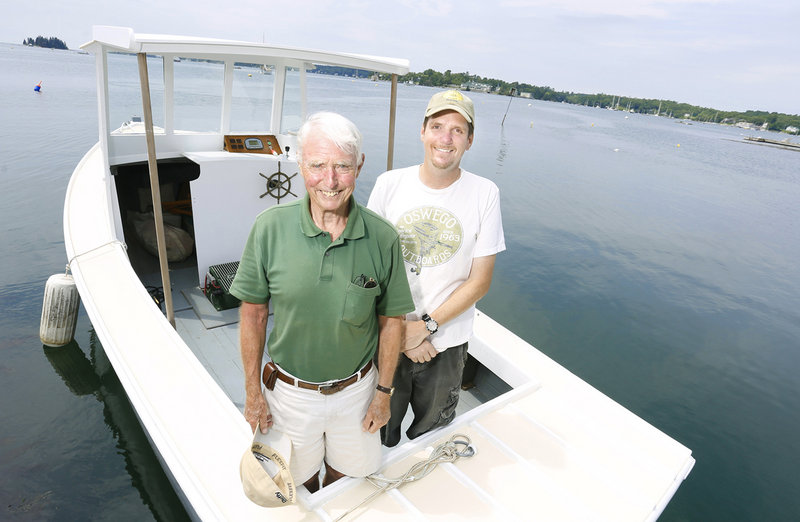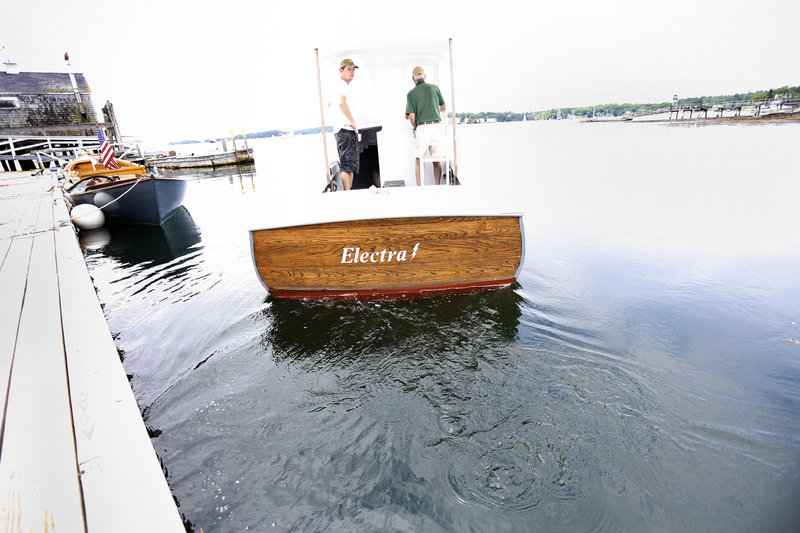BOOTHBAY HARBOR — The throaty diesel rumble, the petroleum smell and wisp of smoke — none of it was present when Eugene Story started the engine on the 23-foot lobster boat docked at the Boothbay Harbor Shipyard in mid-July. Instead, air bubbles in the water from the propeller were the only indication that the vessel was under way.
The boat’s name on the transom – Electra, trailed by a thunderbolt – offered an explanation. Story was piloting an electric lobster boat.
Electra is a prototype for what its developers hope will be a quieter, cleaner and more energy-efficient vessel that could be built here at the shipyard. By next month, the boat will be outfitted with a small diesel generator. That will turn Electra into a diesel-electric hybrid, potentially appealing to boaters looking for a lobster boat-style pleasure craft with greater cruising range. It then will be set for sea trials and potential customers.
Once a rare sight on American roads, hybrid cars, and more recently, electric cars, are becoming common, as the technology improves and motorists become more comfortable with the concept. Boating is about 10 years behind automobiles, but high and volatile fuel prices have set it on a similar course. Story and his partners hope Maine can tap into its boat-building heritage to be a player in this evolving trend.
Story has been promoting battery-powered vessels through his Maine Electric Boat Co. and Elco Motor Yachts of Athens, N.Y., which began developing electric boats more than a century ago and has a line of propulsion systems. Two years ago, he formed a partnership with Eric Graves, president of the Boothbay shipyard, to explore electric engines for the traditional Maine lobster boat.
Story chose the lobster boat because of its classic, seaworthy hull design. Today’s lobster boats have grown larger and more fuel-thirsty, to fish farther offshore. But older designs meant to be powered with a small engine at modest speeds are still around, and the men found what they were looking for when they discovered a 23-foot boat built in East Boothbay in the late 1960s. It had been stored in a barn for 30 years.
“We wanted to build a prototype, but not a big, expensive prototype,” said Story, a retired naval architect who splits his time between Portland and Southport.
Graves rebuilt the boat while Story installed an Elco electric motor. It has a diesel equivalent of 20 horsepower. The total cost of the propulsion system is less than $7,000.
The motor will push Electra through the water at a maxium speed of 6.5 knots, roughly 7.5 miles per hour. Power comes from six batteries seated under the gunwales.
For mariners familiar with standard propulsion, Electra offers a different experience, as a quick spin around the harbor reveals. The most dramatic contrast is the lack of noise when making way and the instant throttle response of the electric motor.
At the helm, digital gauges indicate the engine RPM, amps and battery life. When Electra’s cruising at 4 knots, the batteries can last up to eight hours. Push the throttle forward, however, and battery life falls off exponentially.
That’s a problem for lobster fishing, the men soon realized. Lobster fishermen want to get out to their traps quickly and can be hauling all day. That would kill the battery.
One solution might be to install solar-electric panels. But Electra has a small roof and Story figured it would take two days to fully charge the cells.
That brought Story and Graves around to hybrid technology. Next month, they will install an 8-kilowatt, direct-current diesel generator. Connected to the motor, it will be able to run Electra at 6 knots. At slower speeds, it will charge the battery bank.
Either way, Electra’s never going to compete in Maine lobster boat races, where a 900 horsepower turbo-charged diesel recently was clocked at nearly 60 mph. But a hybrid would greatly increase the boat’s range. And for a burst of power, the batteries and the generator could run in parallel.
This all sounds interesting, but not very practical, to David Cousens, president of the Maine Lobstermen’s Association.
“On a windy day, or close to a ledge, you need to have something powerful and reliable,” he said.
Lobstermen aren’t happy about fuel prices, Cousens said. His 40-foot boat, with its 450 horsepower engine, burns through roughly $100 worth of fuel a day. But any alternative has to be powerful, fuel efficient and affordable, Cousens said, and he doesn’t see those three things coming together soon for commercial applications.
“I can’t see people doing something other than diesel in the very near future,” he said, “but I wish them luck.”
Story and Graves are getting this message, and see a greater opportunity in pleasure craft. There are promising developments going on in that end of the market.
On the all-electric side, for instance, dealers such as West Marine have begun selling the Torqeedo, a German-made, battery-powered outboard. Power was limited to 15 horsepower until this year, fine for a daysailer or dinghy. Now the company is introducing an 80 horsepower version.
On the diesel-electric front, New Englanders this summer can test-drive a yacht that features a solar-electric roof, lithium batteries and a low-drag hull based on sailboats.
Six weeks ago, one of the region’s largest powerboat dealers, Boston-based Russo Marine, began carrying the Greenline, a hybrid yacht built in Slovenia. Russo has a new 33-footer under contract and sold a preowned model during an introductory event last month in Boston Harbor.
The Greenline can take advantage of four power modes. At the dock, it plugs into shore power. Motoring at 4 knots, it can go up to 20 miles on battery power. In diesel mode, it recharges the batteries. At anchor, the solar array also can charge the cells.
The $350,000 price is on par with comparable, twin-engine gas or diesel yachts, according to Larry Russo Sr., the company’s owner and president. One down side, he said, is that the gas vessel can cruise at up to 25 knots, while the hybrid’s top speed is 15 knots. That’s not a big deal for former sailboat owners, who make up 45 percent of Greenline customers. Many of them, especially older sailors, are moving to trawlers for cruising and overnight trips.
“This boat is a perfect transition,” Russo said. “A sailor is used to doing 7 or 8 knots his whole life, so at 15 knots, he feels like he’s racing.”
Russo said he plans to have a Greenline on display next month in Rockland, at the Maine Boats, Homes & Harbors boat show.
By then, Story and Graves plan to have Electra in hybrid mode and ready to take potential customers into the harbor. They agree that the market for former sailors who are looking at trawlers appears strong.
Graves eventually would like to build a diesel-electric model at his shipyard, outfitted it for either cruising or fishing. He’s working now on a new hull design for a 32-foot vessel. It would retain the lobster-boat lines and would be advertised through magazines and boat shows.
“We don’t expect any great explosion of interest from marketing,” Graves said. “That happens when you take people out on it.”
Tux Turkel can be contacted at 791-6462 or at tturkel@mainetoday.com
Send questions/comments to the editors.





Success. Please wait for the page to reload. If the page does not reload within 5 seconds, please refresh the page.
Enter your email and password to access comments.
Hi, to comment on stories you must . This profile is in addition to your subscription and website login.
Already have a commenting profile? .
Invalid username/password.
Please check your email to confirm and complete your registration.
Only subscribers are eligible to post comments. Please subscribe or login first for digital access. Here’s why.
Use the form below to reset your password. When you've submitted your account email, we will send an email with a reset code.